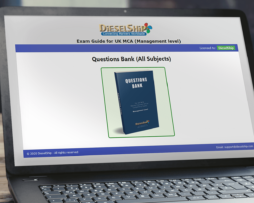E-Book : NAVAL ARCHITECTURE – UK MCA MANAGEMENT LEVEL
E-Book of NAVAL ARCHITECTURE -UK MCA MANAGEMENT LEVEL PAST EXAM QUESTIONS & ANSWERS
- NAVAL ARCHITECTURE -UK MCA MANAGEMENT LEVEL EXAM GUIDE
- Solved answers for past exam question papers (Year 2010 – 2017)
- Clear & legible contents freshly typed & Laser printed
- Solutions arranged chronologically starting from the most recent exam.
- Full set of all 6 academic subjects are available here – UK MCA Management level exam guide – Full set
Please Note:
- E-Books run only on systems with Windows 7 Home edition and above.
Windows 7 Starter and Home Basic editions are not supported. - Android, iOS, Mac and Linux devices are not supported yet.
- The E-Books are locked to one computer use only.
- Support for the software is limited to 24 months from the date of purchase
- No computer (System ID) change is permitted once the E-Book activation code is provided.
E-Book of NAVAL ARCHITECTURE -UK MCA MANAGEMENT LEVEL PAST EXAM QUESTIONS & ANSWERS
- NAVAL ARCHITECTURE -UK MCA MANAGEMENT LEVEL EXAM GUIDE
- Solved answers for past exam question papers (Year 2010 – 2017)
- Clear & legible contents freshly typed & Laser printed
- Solutions arranged chronologically starting from the most recent exam.
- Full set of all 6 academic subjects are available here – UK MCA Management level exam guide – Full set
NAVAL ARCHITECTURE -UK MCA MANAGEMENT LEVEL EXAM GUIDE
III/2 – Naval Architecture
Hydrostatics
Resultant hydrostatic force on an area immersed at any depth in a liquid.
Centre of Pressure of an area immersed at any depth in a liquid.
Archimedes Principle.
Stability and Trim
Principles of flotation.
Simpson’s Rules.
Procedures for determining transverse stability.
Procedures for determining longitudinal stability (trim).
Ship Stresses
Methods of evaluating shear forces and bending moments on ships of simple geometric form.
Ship Resistance
Factors involved in the resistance to motion and the power required for a ship at any given speed.
Methods of estimating power and fuel consumption.
Propellers and Rudders
Propeller terminology and the relationships between engine power and the propeller performance.
Principles of propeller cavitation.
Types of rudders and the effect on the stability of the vessel when helm is applied.
syllabus
The candidate will be able to:
Hydrostatics
Solves problems relating to the resultant thrust and centre of pressure for immersed areas (rectangular, circular, triangular and trapezoidal) positioned vertically and inclined, including when the free surface is subject to a gas pressure.
Calculate the resultant thrust and centre of pressure for a vertical rectangular area wetted by two immiscible liquid, including when the free surface is subject to a gas pressure.
Solve problems relating to Archimedes Principle for bodies floating in and descending vertically through a liquid.
Stability and Trim
Calculate displacement, buoyancy, TPC, KB, KM data of different ship forms for construction and use of hydrostatic curves.
Use Simpson’s Rules or other appropriate method to calculate area, first moment of area and second moment of area used in calculating ships displacement, stability and trim.
Calculate the position of the centre of gravity of a ship under any condition of loading.
Describe the different types of stability and their effect on the ship.
Calculate measures of stability for different load conditions for small angles of heel including the use of the wall sided formula.
Describe the effect of free surface liquids on transverse stability and solves problems involving free surface effect
Describe the inclining experiment and solve problems relating to the inclining experiment.
Use cross curves of stability to determine stability at large angles of heel for varying load conditions.
Describe the effects of the change of form on stability.
Calculate change of trim and end draughts of a ship due to the movement, addition or removal of small masses
Use hydrostatic curves or data to calculate change of trim and end draughts for large mass changes.
Describe and calculate the change of transverse stability due to dry docking.
Solve problems on the change of stability and trim due to bilging.
Ship Stresses
Construct load, shear force and bending moment diagrams for vessels of simple geometric form and load conditions.
Solve problems of load, SF and BM for vessels of simple geometric form and load conditions.
Ship Resistance
Describe and calculate the components of resistance to motion and power required for a ship at any given speed.
Calculate approximate power using Admiralty Coefficient.
Calculate the variation in daily fuel consumption with speed and the fuel requirements for a given voyage.
Propellers and Rudders
Describe propeller terminology and solve problems involving true and apparent slip, thrust, torque and efficiency.
Describe the relationships between powers measured at points between the ship’s engines and the propeller making use of thrust deduction factor, hull efficiency,
propeller efficiency, transmission efficiency, mechanical efficiency, propulsive coefficient and quasi propulsive coefficient.
Describe the phenomenon of propeller cavitation, its causes, effects and methods of reduction.
Distinguish between unbalanced, balanced and semi-balanced rudders and calculate the principal forces acting on the ship and rudder when helm is applied.
Solve problems involving heeling of a ship due to rudder helm being applied
















